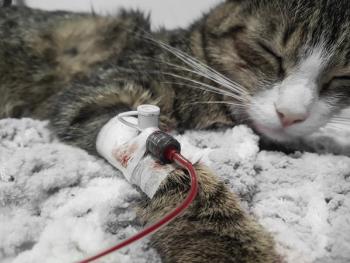
Task force looks to manpower study
Goal: To understand why fewer students are opting for food animal practice
Cleveland-A task force, made up of leaders from food animal medicine groups, are finishing up a "request for proposal" to study the shortage of food animal veterinarians.
Dr. Rod Sydenham, past-president of the American Association of BovinePractitioners (AABP) who is actively involved with the task force, tellsDVM Newsmagazine, the Food Animal Summit Taskforce (FAST) was created tostudy and then find tools and programs that will assist in addressing theshortage of practitioners nationwide.
One goal of FAST is to understand why fewer veterinary students are optingfor food animal practice, make changes and create tools to ease the shortage.Another important area to investigate further is retention of food animalveterinarians in private practice, as well as academia, research and government.
Dr. Tom Burkgren, executive director of AASV, says that the group doesnot want to create another study that collects dust, moreover they wantto improve the situation for the betterment of society.
The request for proposal is slated for completion in early May. Organizationsthat specialize in conducting independent, demographic/market-based studieswill next bid on the project, Sydenham explains.
Once the project coordinator is identified and gets under way, Sydenhamhopes that results from this study may become available as early as nextyear.
FAST is represented by all of the major food animal specialty groupsincluding AABP, American Association of Swine Veterinarians (AASV), Academyof Veterinary Consultants, American Association of Small Ruminant Practitioners,the American Association of Avian Pathologists and the National Commissionon Veterinary Economic Issues and AVMA. The study will look at factors affectingthe applicant pool, recruitment and training into food animal medicine,and retention in food animal practice.
Under the microscope
Once data is compiled it will give the group an overall assessment indeveloping strategies designed at recruiting, training and retaining veterinariansin food animal practice. "We want to affect change in this area,"he explains.
"There is a struggle for mixed and food animal practitioners tofind long-term, full-time people to come and work for them. It is a problemnot only in the United States and Canada, but many parts of the developedworld as well, including Australia, New Zealand and Western Europe."
Burkgren says that recruiting and retention of food animal veterinariansis going to be a major issue for the future.
Swine veterinarians are faced with larger and larger agricultural systems,which is putting stress on veterinarians to fill the demand. One fact iscertain, if there is a need, agriculture will find a way to fill it. FASTwants it to be veterinary medicine.
"There is a real sense among our leadership that there are certainjobs that veterinarians currently do that other professionals, non-DVMs,could take over. We are seeing that happen with some of the bigger systems,"Burkgren explains. "You have to understand that the biggest systemin the United States has more than 700,000 sows and probably less than 10veterinarians. That's one veterinarian to 70,000 sows. You can't even seethat many sows in a year's time. We need more veterinarians," he adds.
FAST was created as a mechanism for the groups to get together to talkabout what each group was doing. It was formed as a planning group, Sydenhamexplains, but has evolved since its initial meeting in late 2001.
The group is now poised to collect facts on a significant issue facingveterinary medicine - succession.
A lot at stake
In the next few years, additional pressure is going to be placed on foodanimal veterinary medicine. The United States Department of Agriculture(USDA) estimates that it will need 584 food animal veterinarians in thattime, not counting attrition. If USDA took five people from each school,it would barely meet their needs, and it is about equal to the number offood animal veterinarians graduating.
Sydenham adds, "So, this is an urgency. FAST's main concern is tocontinue the supply of safe and wholesome animal products. The populationthat is looking after the supply now is aging and there will come a timewhen they retire. We want to make sure there is a continuation of this service.Veterinary medicine is the profession that is best placed to ensure thecontinuation of the supply of safe and wholesome food animal products."
Newsletter
From exam room tips to practice management insights, get trusted veterinary news delivered straight to your inbox—subscribe to dvm360.




